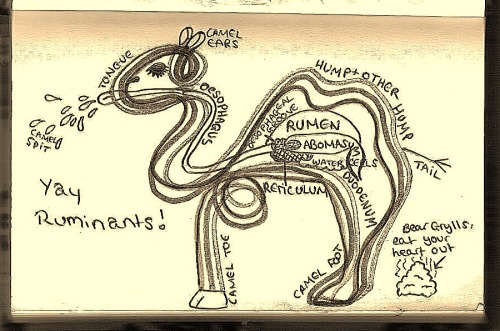I found this interesting information while reading a physiology book about ruminant. Up until this moment, I was wondering the process of rumination instead of regurgitation, remastication and all. Without knowing the true facts, you'd only know the basic concept of rumination, not the whole process. I was surprised to know that I have not encountered this chapter so far, even though we have left ruminant class for a year. So, I think it's not too late to go back while we still have a time recap rumination, simple definition but hard to tell. ;)
*****************************************************
Ruminants (who are they?)
A ruminant is a mammal of the order Artiodactyla that digests plant-based food by initially softening it within the animal's first stomach, then regurgitating the semi-digested mass, now known as cud, and chewing it again.
There are two suborder of ruminants;
1) Ruminantia
Deer, moose, elk, sheep, cow, goat, reindeer, caribou, antelope, giraffe, musk ox, bison
Caribou antelope
musk ox bison
2) Tylopoda: camel, llama, alpaca, vicuna
alpaca llama
vicuna camel
DIFFERENCE BETWEEN RUMINANTIA AND TYLOPODA??
1) Tylopoda do not have OMASUM

Camel digestive system
2. Tylopoda have areas of cardiac glands that open into ventral sacculated surfaces of the reticulum and rumen
The ruminant stomach
Composed of 4 compartments
- Rumen (paunch)
- Reticulum (honeycomb)
- Omasum (many plies)
- Abomasum (true stomach)
Rumen Reticulum
Omasum Abomasum
The ruminant stomach adapted for fermentation of ingested food by bacterial and protozoan microorganism. Energy is obtained through fermentation. Diet of ruminants includes mostly of growing, mature and dried grass and mammalian enzymes cannot digest the cellulose in these materials. However, microbial enzymes can digest the plant cell through fermentation process
The first 3 compartments are also known as forestomach because they precede the true stomach (abomasum). The rumen occupies a prominent portion of the viscera on the left side while reticulum is proximity to the heart as seen on the right side. The abomasum is mostly on the right side.
The position of the stomach's compartments of ruminant
Te abomasum is the largest compartment of the newborn ruminants while in adult ruminant, rumen is the largest forestomach compartment.
When the food (bolus) is passed down from the esophagus, it is deposited in the cranial sac of rumen, the next contraction transfers the contents to the reticulum whereby they can be pumped by reticulum contraction;
- to cardiac opening for regurgitation
- to the omasum through reticulomasum
- to caudal parts of rumen
Densed objects are always retained in the reticulum and may cause hardware disease (traumatic pericarditis)- penetrate to heart or lungs
Summary of ruminants stomach
Rumen
Allows soaking and fermentation of bulk fibrous food and mixing of food
Reticulum
Serves as pump that cause liquid to flow into and out of rumen. The flow of liquid directs ingesta into the rumen, regulates its passage from rumen to omasum, supplies moisture to rumen and floods to cardia(esophagus) before regurgitation
Omasum
Continued fermentation and absorption and regulation of onwards propulsion between reticulum and abomasum.
Abomasum
True stomach function. Digestion of degraded roughages and concentrates begins for fermentation residues that have not been already absorbed.
Rumination Process
The process of bringing the food material back from the ruminant stomach to the mouth for further remastication (chewing). This is the ruminant's strategy to increase the surface area of the chewing feed for maximum absorbtion to be converted as volatile fatty acid (acetic acid, propionate, and butyric acid) for energy and metabolism of ruminant's body
Composed of 4 phases
- Regurgitation
- Remastication
- Resalivation
- Redeglutition (reswallow)
Rumination cycle starts with regurgitation of bolus. Regurgitation is done by taking a breath with closed glottis (opening to trachea) which causes
- Thoracic cavity enlarges without lung inflation
- Intrapleural pressure decrease and lowering pressure in the mediastinal space and organs located within it (eg esophagus)
- Cardia (caudal of esophagus) opens due to lower pressure of esophagus and rumen contents is brought out to the esophagus.
- Reverse peristalsis is initiated and food mass bolus is quickly carried to the mouth.
- Reticulum contracts just before regurgitation to ensure a rumen mixture in the region of cardia. It also clears the cardia of recently swallowed boluses.
(the regurgitation process may be seen on the left sided of neck)
After the regurgitated bolus arrives in mouth, the liquid is squeezed from it and swallowed. Remastication and resalivation occurs simultaneously. The number of chew given to each bolus depending on diet. Redeglutition occurs appropriate time and the next cycle of ruminantion iccurs in 5 second. The
The time spent in rumination each day is varies with species and diet. The more coarse the feed, the more time spend for rumination.
The gases produced in the rumen as a result or fermentation are mainly carbon dioxide (60-70%) and methane (30-40%). Nitrogen, oxygen, and hydrogen present in trace amount as intermediate for other reactions. Carbon dioxide is produce during the fermentation of carbohydrates. and deamination of amino acid and also produce from salivary bicarbonate when it neutralizes the fatty acids produced from microbial fermentation of lipids. Methane is formed by the reduction of carbon dioxide by methane-producing bacteria.
Eructation is the process by which gas from the forestomach is removed by way of the esophagus to the pharynx. It is occurs every 1 minute. The primary stimulus for eructation is the presence of gas in the dorsal sac. If the gas artificially placed into the dorsal rumen, the frequency and volume of eructation increases.
Source; Functional anatomy and physiology of domestic animals, 4th ed, William O Reece, Wiley-Blackwell 2009




















0 comments:
Post a Comment